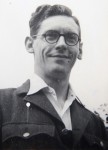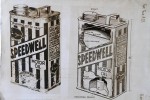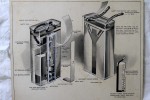 In 2005, the British National Archives released drawings and photographs of Nazi bombs disguised as everyday objects that had been collected by agents of the security service MI5 during World War II. The quotidian objects packed with hidden explosive devices would not be out of place in an episode of Get Smart: chocolate bars, Thermos flasks, cans of motor oil, canned peas, cough drops, lumps of coal, a shoe bomb, and my personal favorite, a tin of Smedley’s English red dessert plums.
In 2005, the British National Archives released drawings and photographs of Nazi bombs disguised as everyday objects that had been collected by agents of the security service MI5 during World War II. The quotidian objects packed with hidden explosive devices would not be out of place in an episode of Get Smart: chocolate bars, Thermos flasks, cans of motor oil, canned peas, cough drops, lumps of coal, a shoe bomb, and my personal favorite, a tin of Smedley’s English red dessert plums.
(The Germans weren’t the only ones trying to sabotage the enemy with disguised explosives. The British can boast booby-trapped Chianti bottles with the bomb obscured by the traditional straw basket on the bottom then topped with wine, exploding beets and exploding cow excrement.)
 MI5 agents intercepted the concealment devices from known Nazi spies and saboteurs, among them Herbert Heinz Tributh, a gymnast from German South-West Africa tasked with blowing up Buckingham Palace, English double agent Eddie “Zigzag” Chapman and French collaborationist Guy Vissault de Coëtlogon. Tributh and his two co-conspirators were caught wandering lost around County Cork Ireland asking random strangers if they knew anybody in the IRA. (Just because they were Nazi spies on a mission to bomb Buckingham Palace doesn’t mean they were any good at it. In their defense, apparently they only got one day of training.) When captured they were carrying four cans of peas packed with explosives.
MI5 agents intercepted the concealment devices from known Nazi spies and saboteurs, among them Herbert Heinz Tributh, a gymnast from German South-West Africa tasked with blowing up Buckingham Palace, English double agent Eddie “Zigzag” Chapman and French collaborationist Guy Vissault de Coëtlogon. Tributh and his two co-conspirators were caught wandering lost around County Cork Ireland asking random strangers if they knew anybody in the IRA. (Just because they were Nazi spies on a mission to bomb Buckingham Palace doesn’t mean they were any good at it. In their defense, apparently they only got one day of training.) When captured they were carrying four cans of peas packed with explosives.
 MI5 was a shoestring operation in those days and its explosives and counter-sabotage unit B1C had exactly three employees: the head Victor Rothschild, scion of the great banking family and 3rd Baron Rothschild, his secretary and future wife Teresa Georgina Mayor, and police detective inspector Donald Fish. None of them were capable of drawing clear and recognizable diagrams of the explosive devices that could be used to train operatives on how to defused then safely. Donald Fish knew someone who could, however: his son, Laurence Fish, a self-taught graphic artist who had worked in advertising before the war.
MI5 was a shoestring operation in those days and its explosives and counter-sabotage unit B1C had exactly three employees: the head Victor Rothschild, scion of the great banking family and 3rd Baron Rothschild, his secretary and future wife Teresa Georgina Mayor, and police detective inspector Donald Fish. None of them were capable of drawing clear and recognizable diagrams of the explosive devices that could be used to train operatives on how to defused then safely. Donald Fish knew someone who could, however: his son, Laurence Fish, a self-taught graphic artist who had worked in advertising before the war.
Rothschild commissioned Laurence Fish to draw the intercepted devices. The letters Rothschild wrote asking Fish to draw, in one now-famous example, an explosive chocolate bar using an operative’s rough sketch as his sole guide, have survived.
Rothschild then asked artist Laurence Fish to draw poster-sized images of the chocolate to warn the public to be on the lookout for the bars.
“I wonder if you could do a drawing for me of an explosive slab of chocolate,” the letter, written from a secret London bunker and addressed to Fish read. “We have received information that the enemy are using pound slabs of chocolate which are made of steel with a very thin covering of real chocolate.”
He continued, “Inside there is high explosive and some form of delay mechanism… When the piece of chocolate is pulled sharply, the canvas is also pulled and this initiates the mechanism.”
 Laurence drew the chocolate bomb and many more explosive devices. He developed a warm and friendly relationship with Rothschild and kept those commission letters for decades, hidden away in his papers. They were only rediscovered in 2009 after Laurence’s death when his widow Jean Bray was looking through his things.
Laurence drew the chocolate bomb and many more explosive devices. He developed a warm and friendly relationship with Rothschild and kept those commission letters for decades, hidden away in his papers. They were only rediscovered in 2009 after Laurence’s death when his widow Jean Bray was looking through his things.
 Of the original drawings, however, no trace remained. Copies were part of the 2005 release, but the hand-drawn diagrams Fish had made were thought to be gone forever. This summer, Victoria Rothschild Gray found more than two dozen of Laurence Fish’s drawings in a chest of drawers in Rushbrooke Hall, the Rothschild estate in Suffolk, England, while cleaning out the house. (It was put on the market by Victoria’s son James, recently wed to hotel heiress Nicki Hilton, in April.) Victoria contacted Jean Bray to let her know of the marvelous find and arranged to give her her husband’s drawings.
Of the original drawings, however, no trace remained. Copies were part of the 2005 release, but the hand-drawn diagrams Fish had made were thought to be gone forever. This summer, Victoria Rothschild Gray found more than two dozen of Laurence Fish’s drawings in a chest of drawers in Rushbrooke Hall, the Rothschild estate in Suffolk, England, while cleaning out the house. (It was put on the market by Victoria’s son James, recently wed to hotel heiress Nicki Hilton, in April.) Victoria contacted Jean Bray to let her know of the marvelous find and arranged to give her her husband’s drawings.
 There are 25 drawings ranging in size from A4, 8.27 x 11.69 inches (the standard page size in Europe), to A1 which is quite large at 11.69 x 16.53 inches. Bray is thrilled to discover they weren’t destroyed during the war. She’s keeping them in her husband’s studio for now, but she would like them to go to a museum or archive which will honor her husband’s clean and detailed freehand graphics and the truth-is-stranger-than-fiction wartime reality they depict.
There are 25 drawings ranging in size from A4, 8.27 x 11.69 inches (the standard page size in Europe), to A1 which is quite large at 11.69 x 16.53 inches. Bray is thrilled to discover they weren’t destroyed during the war. She’s keeping them in her husband’s studio for now, but she would like them to go to a museum or archive which will honor her husband’s clean and detailed freehand graphics and the truth-is-stranger-than-fiction wartime reality they depict.